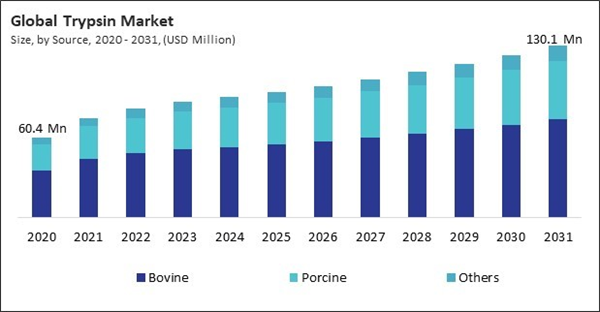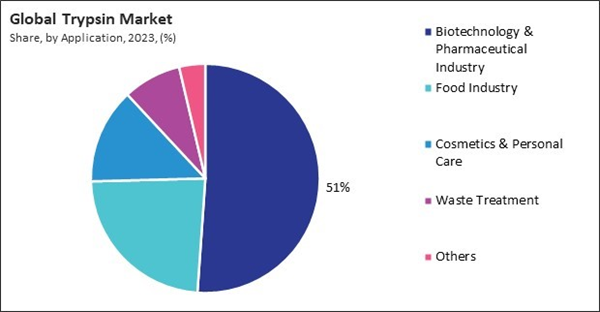Trypsin’s proteolytic activity makes it effective for exfoliating and renewing the skin. Enzymatic exfoliation with trypsin removes dead skin cells, unclogs pores, and promotes cell turnover, resulting in smoother, brighter, and more youthful-looking skin. Thus, the cosmetics and personal care segment attained 13.4% revenue share in the market 2023. Cosmetics and personal care products, such as facial scrubs, masks, and peels, may incorporate trypsin as a key ingredient for gentle and effective exfoliation.
The expansion of biopharmaceutical manufacturing has led to a higher consumption of trypsin. As biopharmaceutical companies scale up production, particularly for therapeutic proteins, vaccines, and biosimilars, the demand for trypsin, essential in cell culture and protein processing, has surged.
Additionally, chronic diseases such as diabetes, cancer, and inflammatory conditions often require treatments that include proteolytic enzymes like trypsin. Trypsin is used in various therapeutic formulations for its anti-inflammatory and wound healing properties, which increases its demand in the medical field.
However, the production of high-purity trypsin, suitable for biopharmaceutical applications, requires complex purification processes. Ensuring the enzyme’s purity and activity involves multiple steps, including filtration, chromatography, and rigorous quality control testing, which add to the overall production costs. Thus, the high production costs of trypsin are impeding the market's growth.
Driving and Restraining Factors
Drivers- Increasing demand in biopharmaceutical manufacturing
- Increasing demand for recombinant proteins
- Growing prevalence of chronic diseases
- High production costs
- Limited shelf-life and stability
- Rising adoption in food and feed industries
- Inclusion in veterinary healthcare products
- Increasing competition from alternative enzymes
- Ethical concerns of trypsin
Source Outlook
Based on source, the market is divided into porcine, bovine, and others. In 2023, the bovine segment garnered 58.9% revenue share in the market. Bovine sources are abundant and readily available in many regions around the world. Cattle farming is prevalent in numerous countries, ensuring a stable and consistent supply of bovine-derived raw materials for trypsin production.Application Outlook
On the basis of application, the market is segmented into biotechnology & pharmaceutical industry, food industry, cosmetics & personal care, waste treatment, and others. In 2023, the food industry segment attained 23.4% revenue share in the market. Trypsin is used in meat processing for its proteolytic activity, which helps tenderize meat by breaking down tough connective tissues.End Use Outlook
By end-use, the market is divided into research, diagnostics, and industrial use. In 2023, the industrial use segment registered 81% revenue share in the market. Trypsin exhibits broad substrate specificity and can act on various proteins, peptides, and proteinaceous materials.Regional Outlook
Region-wise, the market is analyzed across North America, Europe, Asia Pacific, and LAMEA. In 2023, the Asia Pacific region generated 25.4% revenue share in the trypsin market. The Asia-Pacific region is a major food and beverage production hub driven by population growth, urbanization, and changing consumer preferences.List of Key Companies Profiled
- Merck Millipore (Merck KGaA)
- Novozymes A/S (Novo Holdings A/S)
- Agilent Technologies, Inc.
- Thermo Fisher Scientific, Inc.
- Promega Corporation
- Takara Bio Inc. (Takara Holdings Inc.)
- Sartorius AG
- PromoCell GmbH
- Geno Technology, Inc.
- Bio-Rad Laboratories, Inc.
Market Report Segmentation
By Source- Bovine
- Porcine
- Others
- Biotechnology & Pharmaceutical Industry
- Food Industry
- Cosmetics & Personal Care
- Waste Treatment
- Others
- Industrial use
- Research
- Diagnostics
- North America
- US
- Canada
- Mexico
- Rest of North America
- Europe
- Germany
- UK
- France
- Russia
- Spain
- Italy
- Rest of Europe
- Asia Pacific
- China
- Japan
- India
- South Korea
- Singapore
- Malaysia
- Rest of Asia Pacific
- LAMEA
- Brazil
- Argentina
- UAE
- Saudi Arabia
- South Africa
- Nigeria
- Rest of LAMEA
Table of Contents
Companies Mentioned
- Merck Millipore (Merck KGaA)
- Novozymes A/S (Novo Holdings A/S)
- Agilent Technologies, Inc.
- Thermo Fisher Scientific, Inc.
- Promega Corporation
- Takara Bio Inc. (Takara Holdings Inc.)
- Sartorius AG
- PromoCell GmbH
- Geno Technology, Inc.
- Bio-Rad Laboratories, Inc.










